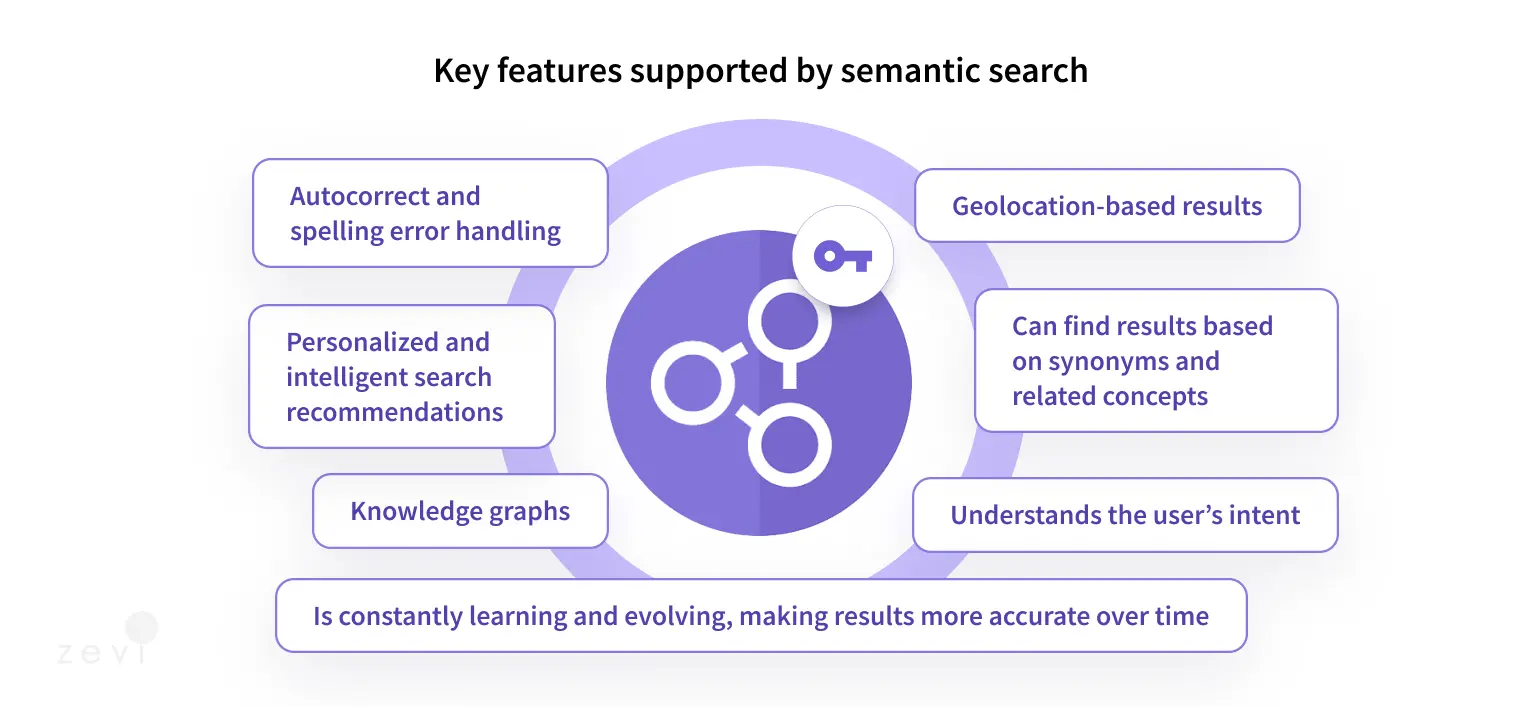Search performance has taken massive strides in recent years, thanks to powerful platforms like Google and Amazon. This is why delivering accurate and relevant search results hold prime importance in today’s digital-first economy. But what does relevance mean?

Understanding search relevance
Doug Turnbull defines search relevance as “the practice of improving search results for users by satisfying their information needs in the context of a particular user experience while balancing how ranking impacts our business’s needs.” In other words, search relevance is fine-tuning and narrowing search results based on certain predefined criteria that are important for both the user and your business.
In the early days of search, relevance was determined by factors like keyword density and metadata. This led to problems where pages could be “keyword stuffed” with little regard for actual quality or relevance, forcing users to wade through results that weren’t actually relevant to their needs. This keyword-based method of retrieval meant inaccurate or sometimes completely unrelated results that left the user frustrated.
Thankfully, search engines have come a long way with the advances in Artificial Intelligence (AI) and machine learning (ML) algorithms such as deep learning and natural language processing (NLP). These sophisticated technologies power intelligent search engines in a way that makes search results acutely tailored to a user's search intent and online behavior.
What is semantic search?
Semantic search denotes search with meaning, as distinguished from lexical search where the search engine looks for literal matches of the query words or variants of them, without understanding the overall meaning of the query.
For example, if you were to search for “men’s shoes” on a semantic search engine, it would not only take into account the keyword match but also look at other factors, such as the type of shoe (e.g., dress vs. running), the style of shoe (e.g., loafers vs. sneakers), and even the occasion for which you might need them (e.g., work vs. casual). It can also deliver results based on the user’s geographical location and markers such as weather and season.

Key features supported by semantic search
Below are 7 prominent features that make semantic search a powerful search technology.
- Autocorrect and spelling error handling.
- Knowledge graphs.
- Personalized and intelligent search recommendations.
- Geolocation-based results.
- Can find results based on synonyms and related concepts.
- Understands the user’s intent.
- Is constantly learning and evolving, making results more accurate over time.
Let's dive deep into them and understand them in detail.
1. Autocorrect and spelling error handling
Autocorrect ensures that misspelled words are corrected before the query is processed, thus providing more accurate results. On the other hand, spelling error handling takes into account different variations of a word (e.g., plurals) to provide more relevant results.
2. Knowledge graphs
A knowledge graph is a data structure that captures relationships between entities and concepts. This allows semantic search engines to understand the real-world connections between things, making it possible to provide more relevant results for queries. Knowledge graphs are used to power features like Google's "People Also Search For" and "Related Searches" boxes.
3. Personalized and intelligent search recommendations
Semantic search returns not only relevant results but also suggests similar or related products that the customer might be interested in. Based on the customer’s past search history and purchase habits, it provides personalized product recommendations to make the shopping experience more intuitive.
4. Geolocation-based results
Many consumers (over 82 percent) now use their mobile devices to perform local searches, looking for businesses or services near them. This has led to a rise in the demand for geolocation-based results from search engines. Semantic search engines offer location-based results by analyzing the user's IP address and using mapping data to determine the user's approximate location. The search engine can then use this information to return results that are relevant to the user's location.
5. Can find results based on synonyms and related concepts
This allows it to better match results with the user's intent, even if the user does not use the same terminology as the system does. This means that if a user searches for "cheap shoes", the platform will not only return results for "inexpensive shoes", but also for other relevant concepts like "sale items" or "clearance items". This makes it easier for users to find what they're looking for, and also reduces the chances of irrelevant results being returned.
Semantic search engines can also automatically expand user queries with related terms or concepts, providing a wider range of results to choose from. This can be particularly helpful when a user is not exactly sure what they are looking for. For example, if a user searches for "shoes", a semantic search engine would also return results for "footwear", "sandals", "boots", and “heels”, all of which can be interpreted under the same broad category of shoes.
6. Understands the user’s intent
To effectively identify user intent, semantic search technology relies on various cues such as the user's past search history, location, time of day, and other factors. It also looks at the structure of the query itself (in combination with NLP) and semantic analysis of web content (including structured data) to identify the meaning and context of terms used in a query.
This technology is constantly evolving and becoming more sophisticated as it has access to more data. For example, RankBrain is a machine-learning artificial intelligence system that helps Google interpret queries that have never been seen before by looking at patterns in past searches.
7. Is constantly learning and evolving, making results more accurate over time
Semantic search combines semantic understanding with search relevance on an ongoing basis to fine-tune search results with time. As the search engine learns more about context through multiple data points and feedback, the results become increasingly accurate and relevant.
How semantic search levels up search relevance
Semantic search engines rely on a number of techniques including NLP, ontologies (taxonomic structures that define the relationships between different concepts in a domain) and machine learning. It relies on extracting metadata from sources and annotating it with semantic information — information that describes the source content in a machine-readable way — to enable search engines to match user queries with relevant results.
The metadata can be in the form of text annotations, structured data, or even unstructured data such as images and videos. By understanding the semantics of this metadata, search engines can better match user queries with relevant results.
Conclusion
In an online economy saturated with hundreds of thousands of brands, serving superior search and shopping experience is an effective way to stand out. Semantic search engines make this possible through an intelligent combination of machine learning algorithms and semantic understanding.
Not only does this help your site search decode the user’s intent, but it also promises increasingly relevant suggestions and results with more time and feedback. AI-powered semantic search solutions like Zevi do this by leveraging powerful search technologies to tailor results for your users.
To experience the power of smart search, book a demo with Zevi today.
.png)
%201.svg)


.png)
.png)
.png)
.svg)
